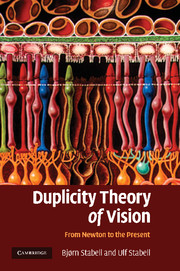Book contents
- Frontmatter
- Contents
- Acknowledgements
- 1 Introduction
- Part I The development of the basic ideas of the duplicity theory from Newton to G. E. Müller
- 2 The Newton tradition
- 3 The Schultze tradition
- 4 The Goethe tradition: the phenomenological approach
- 5 The colour theories of Armin Tschermak and George Elias Müller
- Part II The development of the duplicity theory from 1930–1966
- Part III Chromatic rod vision: a historical account
- Part IV Theories of sensitivity regulation of the rod and cone systems: a historical account
- Part V Factors that triggered the paradigm shifts in the development of the duplicity theory
- References
- Index
4 - The Goethe tradition: the phenomenological approach
Published online by Cambridge University Press: 22 January 2010
- Frontmatter
- Contents
- Acknowledgements
- 1 Introduction
- Part I The development of the basic ideas of the duplicity theory from Newton to G. E. Müller
- 2 The Newton tradition
- 3 The Schultze tradition
- 4 The Goethe tradition: the phenomenological approach
- 5 The colour theories of Armin Tschermak and George Elias Müller
- Part II The development of the duplicity theory from 1930–1966
- Part III Chromatic rod vision: a historical account
- Part IV Theories of sensitivity regulation of the rod and cone systems: a historical account
- Part V Factors that triggered the paradigm shifts in the development of the duplicity theory
- References
- Index
Summary
PHENOMENOLOGICAL ANALYSIS MAY REVEAL UNDERLYING MATERIAL PROCESSES
The almost complete lack of knowledge about colour processing in the visual pathway is quite understandable. How could it be possible to obtain such information without microelectrodes or other advanced instruments at hand to monitor the processing?
An ingenious way out of this apparently insurmountable difficulty was offered by Hering (1878). He held that there were actually two quite different routes to understanding the processes underlying colour vision: a direct physiological approach and an indirect psychological approach. The psychological approach was based on the presumption that information about material processes underlying colour vision may be obtained by analyzing the phenomenological characteristics of colour sensations. Actually, Hering accepted the psychophysical maxim of Mach (1865, p. 320) that made three basic assumptions:
Every mental process is unalterably correlated with an underlying material process.
Similar and different mental processes are, respectively, correlated with similar and different material processes.
Every detail in the mental process corresponds to a detail in the material process.
As may be seen, the maxim of Mach is a specification of Spinoza's principle of psychophysical parallelism. It may also be noted that the maxim is akin to Leibniz's presumption that there is a pre-established conformity between mind and body (e.g. Boring, 1957, pp. 165–168).
Presupposing Mach's maxim to be valid, it would be a straightforward undertaking to obtain information about material processes underlying colour sensation, once an unbiased and comprehensive phenomenological analysis of colour vision was worked out.
- Type
- Chapter
- Information
- Duplicity Theory of VisionFrom Newton to the Present, pp. 41 - 51Publisher: Cambridge University PressPrint publication year: 2009



